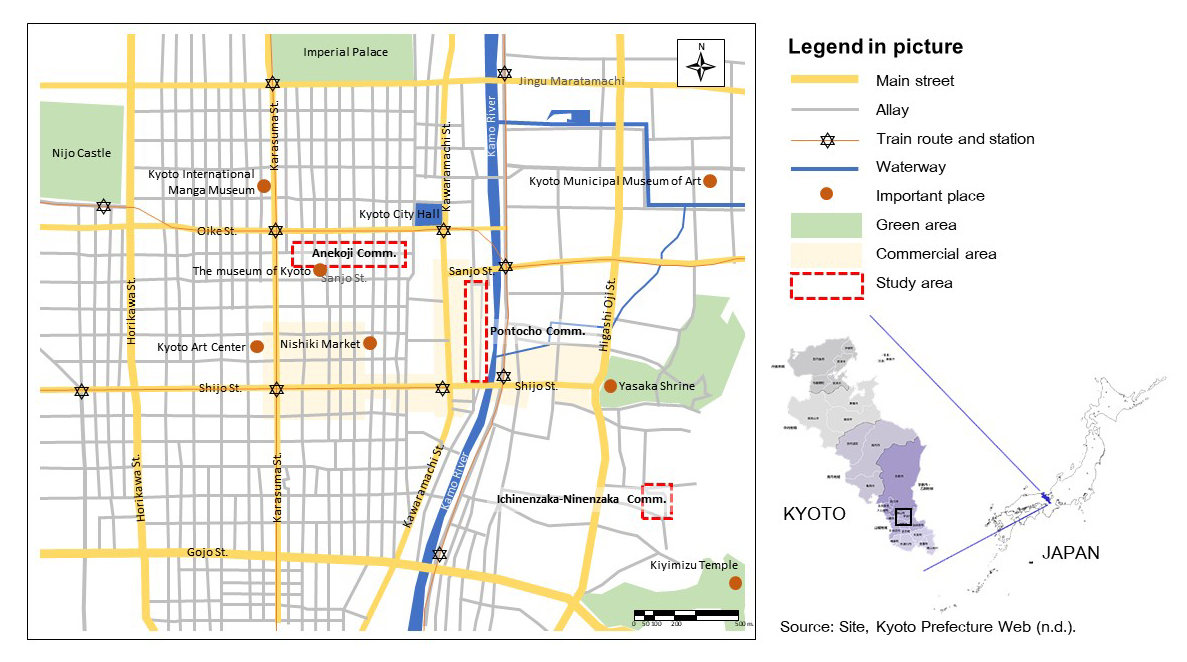A Study of the Importance of Personal Interests Concerning on Urban Planning: Case Studies in Kyoto City, Japan
Main Article Content
Abstract
In the conservation work or urban development terms, the most complicated process is to balance and distinguish personal requirements into group of interests or circulate public of interests for each individual. In Japan, the successful community participation process of “Machizukuri” or “Town making” has been widely accepted because of its activation of community planning achievement, especially in Kyoto. According to “Machizukuri” which refers to a collaboration of communities, Kyoto city and the business operators have followed the principle of the benefit of equivalence between peaceful living of local people and the appropriate income of business. The collaboration has kept Kyoto as a charming city where a diversity of historical image in an early era of Japan and the technological convenient facilities of the city are combined. For these reasons, the objective of this study aims to understand and expose the inner significance of Machizukuri, in order to integrate or generate several interests in the operation of community’s plan. This research has been reviewed and compared through the urban planning activities. The case-studies are separated into the tourist scenery area, living area and economic area within the three historical characteristic areas including Icinenzaka-Ninenzaka, Anekoji Dori and Pontocho. The results have shown the repetitive successful activities that mainly focus on personal interests, which gradually generate the meaningful consequences for the community’s future images. Thus, it is crucial to consider about personal benefits and it needs a greater attention from its community or sustainable urban development planning.
Downloads
Article Details

This work is licensed under a Creative Commons Attribution-NonCommercial-NoDerivatives 4.0 International License.
All material is licensed under the terms of the Creative Commons Attribution 4.0 International (CC-BY-NC-ND 4.0) License, unless otherwise stated. As such, authors are free to share, copy, and redistribute the material in any medium or format. The authors must give appropriate credit, provide a link to the license, and indicate if changes were made. The authors may do so in any reasonable manner, but not in any way that suggests the licensor endorses you or your use. The authors may not use the material for commercial purposes. If the authors remix, transform, or build upon the material, they may not distribute the modified material, unless permission is obtained from JARS. Final, accepted versions of the paper may be posted on third party repositories, provided appropriate acknowledgement to the original source is clearly noted.
References
Anekoji Community Development Committee. (2014). Anekoji case studies: The record of 10 years project of Town Environment Improvement (Meeting Report) (p. 29). Japan: Authors.
Anekoji Community Development Committee. (2015a, January). Anekoji community regional landscape planning plan.
Anekoji Community Development Committee. Japan: Authors.Anekoji Community Development Committee. (2015b, March 31). Building agreement area. Anekoji Community Development Committee. Japan: Authors.
Centre, U. W. H. (n.d.). Historic Monuments of Ancient Kyoto (Kyoto, Uji and Otsu Cities). Retrieved April 25, 2018, from https://whc.unesco.org/en/list/688/.
Centre, U. W. H. (n.d.). Sharing best practices in World Heritage management. Retrieved April 25, 2018, from https://whc.unesco.org/en/recognition-of-best-practices/.
Doxiadis, K. A. (1968). Ekistics: An introduction to the science of human settlements. London: Oxford University Press.IAP2 Southern Africa. (n.d.).
IAP2 Spectrum – IAP2 Southern Africa. Retrieved April 25, 2018, from http://iap2sa.org/?page_id=908.
Issarathumnoon, W. (2006). The Machizukuri bottom-up approach to conservation of historic communities: Lessons for Thailand. In Power, Purpose, Process, and Practice in Asia The Work of the 2003/2004 API Fellows. Kuala Lumpur, Malaysia: API Fellows. #page=108.
Kyoto City. (2007). Kyoto city landscape policy: Forming timeless and radiant Kyoto landscapes (September 2007). Japan: Authors.
Kyoto City. (2015, March 8). Kyoto city regional landscape town planning network. Japan: Kyoto City.
Kyoto City. (n.d.). Kyoto city: Regional landscape conservation council system. Japan: Kyoto City.
Kyoto City. (n.d.-b). Landscape of Kyoto. Japan: Kyoto City.
Pontocho Town Development Committee. (2015, January 4). Pontocho landscape improvement district. Japan: Authors.
Pontocho Town Development Committee. (n.d.). Landscape planning plan. Japan: Authors.
Pontocho Town Development Committee. (n.d.). Pontocho town rule (Pontocho-Cho-Shikumuka). Japan: Authors.
Roger Schwarz, R. & Associates, Inc. (n.d.). An approach that gets you and your team moving forward together. Retrieved April 25, 2018, from http://www.schwarzassociates.com/what-is-the-mutual-learning-approach/.
Site, Kyoto Prefecture Web. (n.d.). Kyoto prefecture’s natural environment | Red data book of Kyoto prefecture 2015. Retrieved October 4, 2018, from http://www.pref.kyoto.jp/kankyo/rdb/en/info/en_nature.html
The Landscape Creation Committee. (2013, April). Ichinenzaka-Ninenzaka pegional landscape planning plan. Japan: Ichinenzaka-Ninenzaka Landscape Creation Committee.
Watanabe, J. S. (2009). Toshi Keikaku vs Machizukuri Emerging paradigm of civil society in Japan, 1950-1980. In Living City in Japan (Digital Printing, 2009). New York: Simultaneously published.


